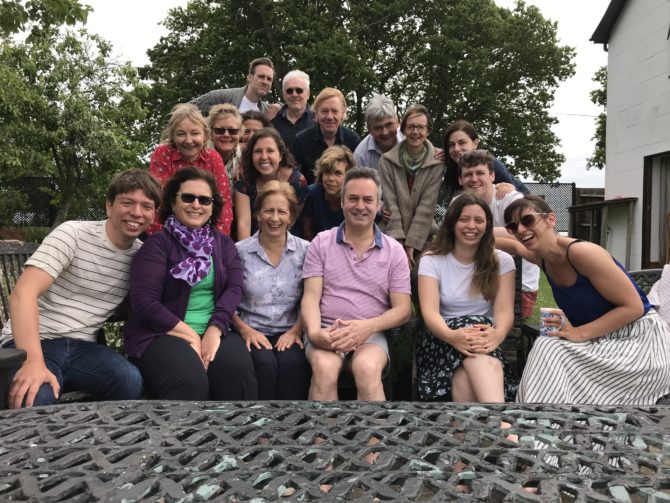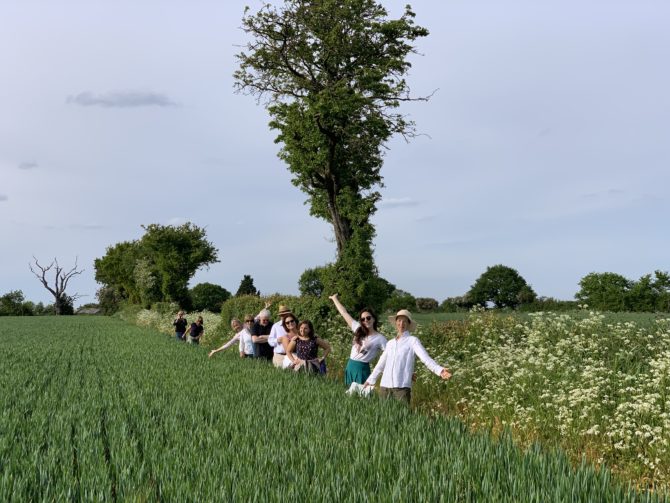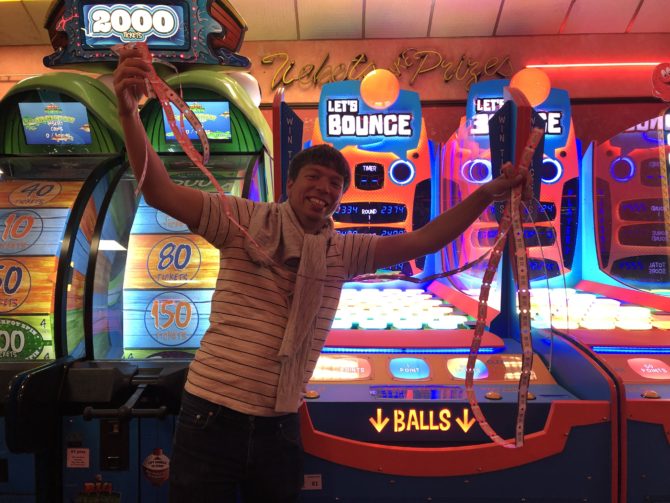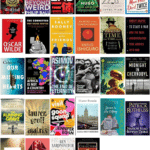Normal life is about to resume! Next week I’m excited to be starting a new job at eviivo and am just hoping not to alienate my new colleagues by showing too much uncontrolled enthusiasm for commuting, security passes, team meetings and all the other accoutrements of work which I’ve been on hiatus from since November. As usual, I won’t be blogging about work itself, but it is telling of something that I’ve swapped a giant cat-in-a-spaceship for a singing sheep with a song which is now firmly stuck in my head.
And in a spirit of radical efficiency, this weekend Randi and I will also be moving into our new flat!

As I’ve written before, I really wanted to combine ‘moving back to London’ with living somewhere new and different, and over a few nights the other week we bounced between flat viewings in the vague areas of Peckham, Brixton and Herne Hill looking for the perfect spot. Like an episode of Location, Location, Location (which we’ve been consuming a lot of recently – for the non-UK readers, it’s a reality show about house-hunting) we had to carefully balance transport connections and parks – amongst other things – but I’m really happy about discovering the beautiful Brockwell Park and the soon-to-be-ours flat nearby. Importantly, we will also have a spare room, so anyone reading this and thinking “I can’t possibly visit from California / Chicago / North West London in a day” can set their mind at ease. There’s a bed with your name on it.
In the mean time we are very grateful to our slate of temporary hosts: my aunt, my mum and family friends Susan and Gordon who invited us to house sit (and cat sit) for two weeks while they were away. (OK, technically they invited Tash but you can’t always get your first choice.) This was a great base to finalise job and flat searches as well as feed our aforementioned Location, Location, Location addiction. I’m not joking about this. By the end we were referring to it as “L cubed” to save time. One evening I was curious about how far back Channel 4’s on-demand archives went and we ended up watching the very first episode from 2000. The craziest thing about this was not how young the presenters look, or the insultingly low house prices, or the bizarre home-video filming style and soundtrack but the scene where a prospective buyer is worried about the length of her potential commute from Stoke Newington and Phil calls up the London Travel Enquiries hotline to get the answer. The London Travel Enquiries hotline? I guess this was what people did in the year 2000, but it felt so jarringly absurd.

Throwing me into an even deeper funk recently has been Russell T Davies’s new drama Years & Years. It’s along the lines of Black Mirror crossed with Turn Left and, as you would expect, the plot is gripping and the characterisation excellent. My only criticism is that it makes me want to bury my head under a pillow to hide from the world and then plan my escape to a small cottage in the countryside. The New Zealand countryside. In the year 2000, or perhaps even further back before even the London Travel Enquiries hotline got going.
Back in the real world I’ve also caught up with Sanna, walked two more London LOOP sections and hung out with Oliver and Abi at the Natural History Museum and Hyde Park where we watched a succession of poorly-matched young children go head-to-head in goal scoring while their birthday party organiser and/or football coach yelled words of encouragement. Randi and I also saw Rocketman – the new Elton John musical biopic – at the Lexi which I thoroughly enjoyed.
In a final flourish of accomplishment I have even found a way to rescue my stranded 401k (US retirement savings) from the ticking time bomb which started after I left Groupon and had one year to ‘rollover’ my savings into a new type of account which is only available to US residents. “I wish there was a way of doing this all globally” I said to the helpful guy on the phone from Merrill Lynch, who replied brightly that “we’ll get there eventually”. Clearly he hasn’t been watching Years & Years.
This Bank Holiday weekend we gathered this lot:

into one enormous cottage in the small Essex village of Thorpe-le-Soken:

for my mum’s surprise 60th birthday party!
Tash and Katie deserve the credit for planning this all while I was travelling, and on Saturday morning they drove mum up for their ‘mystery weekend’ together while Randi, Cormac and I hopped on a train from Liverpool Street and joined a bunch of friends and relatives for the surprise. We all then enjoyed a long weekend together of amazing (and plentiful!) cooking, inappropriately early-morning games of Cards Against Humanity, confusing country walks along Essex ‘footpaths’ which are falling into overgrown oblivion, a trip to the seaside (with top-class dodgem driving) and Cormac’s incredible rendition of The Jungle Book’s I Wanna Be Like You on the guitar.




Oh, and some of us shut ourselves away on Sunday night to watch the European Election results. Others just danced instead.

My sisters and I also finally got the chance to present our mum with a book of childhood photo recreations. This is a project which we’ve been putting together over the past year whenever we’ve had the chance, and it has been worryingly easy to locate many of the props from photos which are now several decades old, from duvet covers to garden chairs to a fancy dress gorilla hat. But I’m pleased that our inability to throw anything away made it easier to get the perfect matching shot, and we were all sufficiently proud of this book to order extra copies for ourselves too.



Just before the weekend we also made very good progress on our collective job+flat hunting. But I will save that for the next post 😉
With every new series of Would I Lie To You? which aired while I was living in Chicago I got ever more concerned that the show would be cancelled before I’d get a chance to go and see it being recorded in person. So when I saw an e-mail from SRO Audiences during one of our overnight train rides in Asia that the ballot for Series 13 (!) was opening I entered straight away and was lucky enough to get tickets for the opening episodes two nights in a row. Since tickets are free this also doubled as a very inexpensive birthday present for Randi. 😇
The show is recorded at Pinewood Studios out in the middle of nowhere, which means a trip all the way to the Uxbridge end of the Metropolitan line and then a 10-minute Uber costing ten times as much for the final bit. Sadly, once you cross out of the Greater London boundary the buses dwindle to near-nothingness and the quickest route is unwalkable due to a missing pavement. (There was a New York MTA bus lying around the studio lot but this is presumably just a prop.) But we had the time and luck to land seats in the very front row on the first night so we got to be right up close to Richard Osman and Jennifer Saunders on David Mitchell’s team, with Joe Sugg and Steph McGovern sitting across on the other side with Lee Mack. (Publishing guest names seems unobjectionable given what already exists on Reddit.)
Being so close to the performers actually made us both feel a little nervous, and in some ways I enjoyed the second night more (with Claudia Winkleman, Guz Khan, Greg Davies and Lucy Worsley) from a safer position nearer the back. From this perspective it also felt more like laughing at a (very extended) TV episode rather than being right in the thick of it, but both nights were incredibly fun and I’m delighted I can now cross live Would I Lie To You? off my bucket list. (Although I don’t actually have a bucket list since it’s much easier to fill it in retrospectively.)

The night afterwards we stayed near the village of Datchet on my aunt Sally’s incredible floating home. I say ‘floating home’ because although this has previously been described to me as a ‘houseboat’ that term made me picture a cramped space on a canal rather than beautiful and relaxed living on the Thames. We also had a good walk through Windsor – bringing back fond memories of GCSE Humanities coursework – which accidentally ticked off a few British tourism boxes for Randi including Windsor Castle (at least from the outside) and some unanticipated Morris dancing.
Like Diamond Geezer I had never actually been to the Ye Olde Swiss Cottage pub by Swiss Cottage tube station (and encircled by an awful roundabout which Westminster council keep trying to protect) so it was a good spot for us to catch-up in person and swap notes on various nerdy topics. At a much bougier lunch the next week in Exmouth Market I caught up with Cat and Matt during one of Cat’s flying visits to the UK since – hilariously – Cat and I have basically swapped places and she is now living in Madison, Wisconsin. At least it sounds as if my advice about Culver’s (i.e. to eat there enthusiastically and often) has been heeded.

I’ve been lucky enough to have had job interviews over the past few weeks at a really interesting range of places – from bigger companies to tiny start-ups – including one which required an afternoon visit to Nottingham. Unfortunately the Castle was surrounded by scaffolding when I was there, but I did establish that the city centre is chock-a-block with trams to an impressive degree. Meanwhile, Randi has now fully locked-down a job which (a) is awesome, (b) was another reason to celebrate at her birthday dinner with my mum and (c) brings us a step closer to actually moving to one of the neighbourhoods we have been scouting. Further parts of South London met with great approval yesterday, East London less so. (But hey, I did make my first TfL Rail journey – a brand which was meant to have been and gone before I ever got back to London.)
Saturday night was a low-key (but enjoyable) Eurovision at Josh and Anna’s, albeit with a bafflingly unmemorable song from the Netherlands winning. I didn’t have a clear stand-out favourite but I did cast a vote for the bouncy Czech Republic boys because I was giddy with the power of being enfranchised again. I also understand those who protested and thought this opinion piece the next day was worth reading on what it says that the Palestinian flag alone elicits such an hostile reaction in Tel Aviv. Having made another opportunistic use of Josh and Anna’s spare bedroom in Kingsbury, we then migrated to Andrew and Bonnie’s on Sunday for a grand post-10K brunch (other people ran the 10K but I helped to eat the brunch) and undemocratic card games.
Finally – and I know this blog has been a bit all over the place – I wanted to pay my respects to Sanna’s dad, Rod, whose funeral was on Friday. I would never claim to have known him well. Parents of school friends are often fleeting figures, but I did meet him quite a few times over the years when Sanna and I were at school together and he was the kind of person you knew immediately was kind, loving and wise. After a long time I was very fortunate to see him again, the Christmas before last, as we all sat around their kitchen table and chatted in the warm family glow. I know he is missed.
One of the things I was most excited to start once we got back to London was the London LOOP, a 242km walking trail around the very edge of the city which is divided into 24 numbered sections. TfL provide a detailed walking guide for each one on their website and last Sunday we kicked off our long journey with Section 15 (Hatch End to Elstree). Then today we made an ambitiously early start for a Bank Holiday Monday to go back up to Elstree and pick up Section 16 to Cockfosters. Both of these sections were at the extreme end in terms of section length (16/17km) so after several hours of walking we were tired and eager for lunch, but it’s a really nice routine to get into and when we finally complete it all I’m not ashamed to admit that I will be printing off the certificate as a prize for myself. Check back in a year or so!

I’m not going to do exhaustive reviews of each walk – there are plenty of better blogs for that. But the first section really brought home to me some things which are pretty distinctive about this country… or at least very different to the US. At one point we tramped through a field which bordered the M1, for example, and it was so tiddly compared to any freeway which cuts through Chicago. You also wouldn’t find any public footpath there which cut through a private golf course, or passive aggressive signs which reluctantly acknowledge your legal right of way.
And, as ever, I’m filled with mixed emotions about the Green Belt. I’m proud that, as a Londoner, you can get on a train and be out in the countryside in half an hour. It’s no doubt a good thing that the city wasn’t allowed to sprawl forever into low-density suburbs. At the same time, I’m just really sad that Elstree South tube station will never exist, and the Northern line will never join up properly as it should have done. Still, so far on the walks we’ve been treated to a good mixture of fields, woods and playgrounds as well as quiet residential streets and outrageous mansions, and I suppose that concreting over many of these would have been the price for a more satisfying Tube map in the end.


Other than starting the LOOP – and, of course, lots and lots of phone calls with recruiters and job interviews – I’ve caught up with my uncle Andrew over a hearty lunch at Arthur’s Café (great place) and had a very meandering and enjoyable tea with Sally. My mum also bought tickets for us (along with Tash, Katie and Cormac) to see Small Island at the National Theatre. I read the book a few years ago and my memory of the plot was a bit hazy, which in some ways is the most enjoyable state of mind for watching an adaption because you have some references but also surprises. I really enjoyed the production, as well as the theatre itself.
Finally, Randi and I spent a morning traipsing around Clapham and Balham and admiring these new areas of London where we might be interested in living. Despite my hardwired aversion to South London it’s also true that I’m looking for somewhere new which we can both explore together, and I can confirm that both of these places seemed pretty… liveable. As attractive as open fields are, though, I can safely say that we won’t be going so far out to actually live on the LOOP 😉
This blog is fifteen years’ old today! Which means, since I am almost-but-not-quite 30, that I have now been blogging for over half of my entire life. (I’m not sure if that’s a cause for celebration or just slightly frightening.) It also means that my blog has now entered a new phase of child development with “a deeper capacity for caring and sharing” and “more concern about future school and work plans”. So in the spirit of caring and sharing, here are a few Easter highlights since arriving back in London last week.

We were very lucky to be able to time our return to just catch Randi’s school friend Melissa while she was still visiting the UK. She wanted to visit Brighton and so we caught the train down for a day trip on Easter Friday, Randi and I both armed with shiny new Railcards which – given the amount of travelling around the UK we’re planning to do – are going to pay off very quickly. We took in all the kitsch of the pier before Randi led us in the direction of Brighton’s “best fish and chips” where she got more fish than she was bargaining for. Later we relaxed in the gardens of the Royal Pavilion. I’ve been to Brighton a couple of times before but didn’t remember how nice these gardens were, helped by the amazing sunshine and enlivened by the bloke wandering up and down trying to sell bird whistles with a practical demonstration.

That night we arrived back at my family home for one of the least convincing Passover Seder nights ever put on by any group of people. I’m still not entirely clear why this happened and Randi was deeply sceptical at the challah bread and salted caramel brownies, but whatever it was it was a lot of fun. One of my favourite absurdities was when I successfully found the afikoman and discovered that it came with a box of Easter eggs.

We also took Melissa to Hampstead Heath (lovely as always) and Camden Market (surely a bad location for climate change protests since the crowd was already so heaving it was hardly noticeable) before she left for Paris, and on Sunday night we moved on to visit Joshua in his new flat in the far-away lands of Kingsbury. I can already tell that moving back to London with Randi is going to inspire me to discover whole new areas of London and I was amazed to discover that a quaint country village – complete with quiet, windy roads – has been nestling a couple of stops up the Jubilee line this whole time. We admired Josh’s huge garden, gobbled up dinner, shared some wine and then fell asleep in his spare bedroom.
While Josh and I have always stayed in touch, I haven’t seen Rishal since… well, maybe 2011 (when he last showed up in this blog) and certainly not since I moved to Chicago. So it was incredibly wonderful to hang out in Willesden’s Beer & Burger (they didn’t have this in my day) and catch up over many years of life developments. Afterwards I walked back to his parents’ house with the hopes of seeing them again, and was rewarded not only with their company but also a large bag of assorted McVitie’s products… just like the old days, when his dad worked for them and would always have boxes of biscuits lying around.
Finally, Randi and I spent a night admiring Tash’s enviable new flat in Shepherd’s Bush over falafel and wine. We’re not actively looking for a permanent home yet, but anywhere we go is being closely assessed for its parks, buses and takeaways…

















